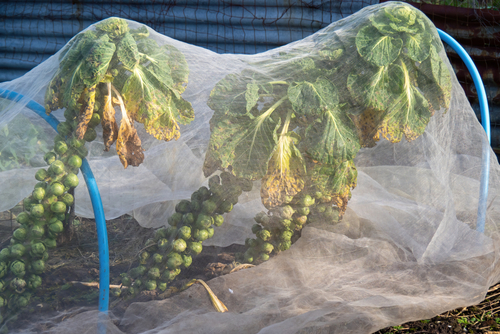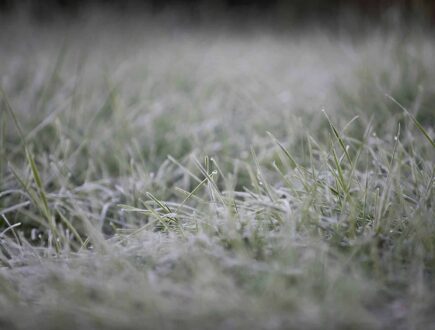Log in or create new account to save this product to your wishlist.

How to Protect Your Plants from Frost: 4 Top Tips
Up your plant care game this winter. Explore quick & easy ideas to shield your plants from frost & ensure they thrive in chilly temperatures.
🌱 All important maintenance moments for your lawn during the year. Leave your email and we will send you the lawn calendar for free.
Enter your email
Receive the lawn calendar in the mail
Enjoy a green lawn all year round!

- Order by 2PM = shipped today
- 250.000+ satisfied customers!
- 60 day satisfaction guarantee
Every gardener knows the importance of protecting their plants from frost, which damages leaves, flowers, and entire crops if left exposed. Fortunately, there are simple ways to protect your plants from low temperatures during the winter. Read on to find out how to protect your plants from frost?
From covering your plants with blankets, old carpets, or plastic to adding mulch, straw, or horticultural fleece, this blog shares four top tips about how to protect your plants from frost this winter.
So, let’s go!
What is frost? And why is it harmful to plants?
Frost occurs when moisture in the air freezes, creating tiny ice crystals which cling to surfaces, including your plants.
And while it can be nice to look at, frost is the enemy of many garden plants: ice crystals will damage your plant’s cells, leading to wilting, discolouration, and even death.
So, wrap your plants up nice and warm this winter, or bring them inside.
This is how to wrap your plants for warmth:
Tip 1: Cover your plants with a blanket or plastic

Horticultural fleece is a lightweight, typically transparent, material designed to wrap around your plants, protecting them from harsh weather conditions and pests.
Traditionally, gardeners used transparent polythene sheets with tiny perforations to aid air circulation. And while these are effective, they can cause overheating and lack nighttime insulation.
So, these days, polythene has been superseded by polypropylene fleece (aka horticultural fleece), which is white-coloured, warm to the touch, and extremely lightweight. And with greatly improved insulation properties, horticultural fleece is ideal for tender plants, providing a layer of protection that helps them make it through the winter.
Remember, whatever you use to cover your plants, ensure daylight can still get through.
Tip 2: Add mulch or straw to protect the roots

A horticultural fleece or plastic sheet helps the tender plant upper, but what about the roots?
Because if the soil freezes, so do your plant’s roots. And while some plants are more frost-resistant than others, keeping the earth warm around the root network is a good idea.
So, add a layer of mulch, such as straw, wood chippings, leaf mould, or compost, which will help protect the soil from frost.
Mulch has a range of benefits:
- Keeps the soil warm
- Helps prevent weeds
- Feeds the soil
Indeed, if you add a layer of organic mulch around a plant’s base, it keeps the soil warm and feeds the earth at the same time.
Find out everything you’ve ever wanted to know about mulch (but were afraid to ask).
Tip 3: Warm up the soil
If your garden is prone to freezing in winter, consider installing an under-soil heating system. And while this might sound like a luxury more associated with premier league football stadiums, under-soil warming cables are surprisingly inexpensive.
Soil heating systems are particularly effective in greenhouses but offer adequate soil frost protection for your flowerbeds as well.
These simple devices look like an extended length of power cable that you bury underneath the soil surface, providing up to 40ºC of warmth. And while we’re all conscious of our electricity spend at the moment, a 3m cable typically uses just 27W of power, costing around 17p a day.
Tip 4: Frost-resistant planting

Covering your plants with fleece and mulch can be time-consuming. So, the other alternative is to choose frost-resistant plants, which will survive exposure to some frost without much trouble.
These are some of the best frost-resistant plants:
Frost resistant veg
- Cabbage
- Spinach
- Parsnip
- Radish
- Cauliflower
- Brussel sprouts
- Turnip
- Celery
- Sage
- Rosemary
- Potato
- Kohl rabi
Flowerbed plants
- Pansy
- Lavender
- Holly
- Lily of the Valley
- Peony
- Hellebore
- Crane’s bill
- Showy Stonecrop
- Echinacea
- Bee balm
- Wild Columbine
- Coral bells
- Siberian Iris
- Moonbeam Coreopsis
- Baptisia
- Catmint
- False sunflower
- New England Aster
- Hosta
Bonus tip!
If your soil is prone to flooding, add plenty of organic matter to aid drainage. Because waterlogged soil is more susceptible to freezing.
How to Protect Your Plants from Frost
Thanks for reading my four top tips for protecting your plants from frost. I hope I’ve provided enough information to help.
But if you have any questions, don’t hesitate to get in touch.
Or explore our comprehensive Help & Advice section for expert gardening and lawn care tips,
Thanks for reading.
-
Zero-Waste Gardening – This is How You Do It!Did you know that the average person wastes between 100 and 150 kilos of food every year? That's why the concept of zero-waste gardening is becoming increasingly important for environmentally conscious gardeners that like to do their gardening greener.Read more
-
How to Master Tree Pollarding: A Practical GuidePretty dense! What might be an insult to some, is certainly a compliment to trees. Through pollarding, you can make sure, your trees have a dense crown of beautiful leaves.Read more
-
Get Ready: Here are 5 Garden Trends for 2025Curious about the latest garden trends for 2025? From smart solutions to sustainable choices, discover all the outdoor trends that are transforming British gardens!Read more
-
How to Care for Plants in Winter: A Simple GuideWhen winter comes around, the care requirements of your plants change. Find out, how to adjust the care routine for your plants.Read more
-
Companion Planting Made Easy: A Step-by-Step TutorialStrategic plant partnerships can solve common gardening problems like pest invasion and disappointing yields. Find out which plants are great together in our companion planting guide.Read more
-
How to Grow Sweet Potatoes in Your GardenWant to know something splendid? A single sweet potato plant can produce 5 to 10 pounds (4.54 kg) of nutritious tubers—plenty to keep your family’s pantry well-stocked for weeks!Read more
-
Revive Your Lawn After Winter With These Easy StepsTired of winter lawn damage? Discover how to repair brown spots, remove weeds, and revitalise your grass for a thriving garden this spring.Read more
-
A Complete Guide On Lighting for Your House PlantsAchieve perfect lighting for houseplants! This guide covers light mapping, plant placement, and grow light tips to help your plants flourish indoors.Read more
Leave a comment
Your answer will be displayed on the site and the interested party will be notified by email.
Leave a comment
Have a question or want to share your experience? Leave us a comment.

- Order by 2PM = shipped today
- 250.000+ satisfied customers!
- 60 day satisfaction guarantee

- Order by 2PM = shipped today
- 250.000+ satisfied customers!
- 60 day satisfaction guarantee

🌱 All important maintenance moments for your lawn during the year. Leave your email and we will send you the lawn calendar for free.
Enter your email
Receive the lawn calendar in the mail
Enjoy a green lawn all year round!






















Comments (0)
There are no comments yet. Well then, what are you waiting for to
Be the first to write your comment!inaugurate this pretty page?
Do you have some comments?